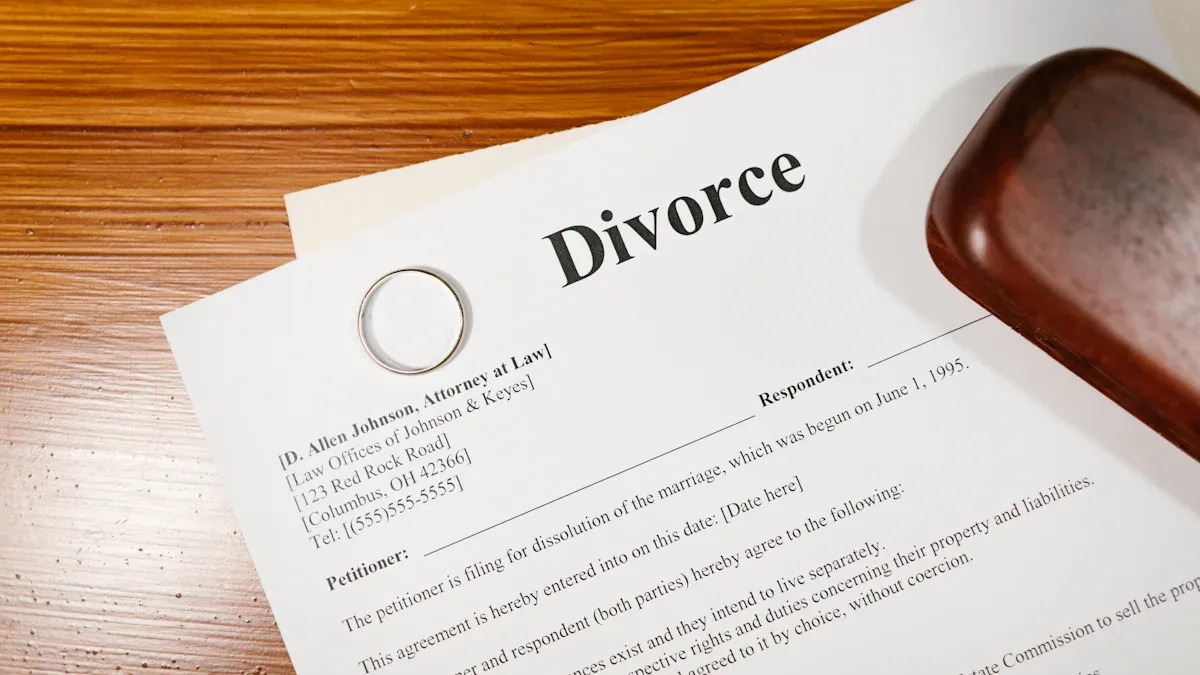Step-by-Step Guide to Filing for Divorce in Texas

Filing for a Texas divorce can seem hard, but knowing the steps helps. In Texas, fewer people are getting divorced now than before. In 2023, there were about 2.7 divorces for every 1,000 people. Women start 69% of Texas divorces, often saying the marriage can't work anymore. If you want to file for divorce in Texas, you must live there for a certain time and follow the rules. Whether you're in Johnson County, with the most divorces, or Fort Bend County, with the least, learning the rules makes the Texas divorce process easier.
Overview of Texas Divorce Laws

Residency Requirements
To file for divorce in Texas, you must meet residency rules. You or your spouse must live in Texas for six months. Also, you need to live in your county for 90 days. These rules let Texas courts handle your case. Texas has average residency rules compared to other states. Always check if you qualify before starting the process.
Grounds for Divorce
In Texas, you can file for no-fault or fault-based divorce. Most people choose no-fault, saying the marriage cannot be fixed. Fault-based reasons include cheating, cruelty, or being abandoned for a year. Other reasons are jail time, mental hospital stays for three years, or living apart for three years. Problems like cheating, money issues, and not getting along often cause divorce. Not getting along is the top reason, causing 43% of divorces in Texas.
Contested vs. Uncontested Divorce in Texas
You must decide if your divorce is contested or uncontested. In an uncontested divorce, both spouses agree on everything. This type is faster and cheaper, costing $1,000 to $3,000 and taking a few months. A contested divorce happens when spouses disagree, needing court help. These cases take longer and cost $10,000 to $30,000. Contested divorces are also more stressful because of long legal fights.
Feature | Uncontested Divorce | Contested Divorce |
|---|---|---|
Agreement | Both agree on all terms. | Court settles disagreements. |
Cost | $1,000–$3,000 | $10,000–$30,000 |
Timeline | 1–3 months after waiting | Months to years |
Emotional Toll | Lower due to agreement | Higher due to conflict |
Legal Steps | Few court steps needed | Many legal steps involved |
Knowing these divorce types helps you choose the best option for you.
Step-by-Step Process to File for Divorce in Texas

Check If You Meet Residency Rules
Before filing for divorce, you must meet Texas residency rules. These rules let Texas courts handle your divorce case. Here's what you need to know:
You must live in your county for at least 90 days.
Requirement | Time Needed |
|---|---|
Live in Texas | 6 months minimum |
Live in County | 90 days minimum |
If you meet these rules, you can start the divorce process. If not, wait until you qualify to file.
Decide If You Need a Lawyer
Divorce can be tricky, especially if you and your spouse argue. A lawyer can make things easier and less stressful. Here’s why hiring one helps:
Lawyers improve your chances in child custody and property cases.
They know family law and handle all legal details for you.
Lawyers stay calm and help avoid fights during the process.
If your divorce is simple, you might handle it alone. But for tough cases or those with kids, a lawyer can save time and protect your rights.
Write and File the Divorce Petition
The next step is to write and file your divorce petition. This paper officially starts your divorce case. It must include basic details like:
Your name and your spouse’s name.
Marriage details, like when and where you got married.
The reason for divorce, like no-fault or fault-based.
Once done, file it at your county’s district clerk office. You’ll pay a filing fee, which depends on your county. After filing, the court gives you a case number, and your divorce officially begins.
Serve Divorce Papers to Your Spouse
After filing for divorce in Texas, you must give the papers to your spouse. This step makes sure they know about the divorce. Texas law allows different ways to do this:
Personal service: You can hire a sheriff, constable, or process server to hand the papers directly to your spouse.
Waiver of service: If your spouse agrees, they can sign a form saying they got the papers. This skips the need for formal delivery.
Certified mail: Send the papers using certified or registered mail with a return receipt.
Alternative service: If other methods don’t work, ask the court to allow options like email or publishing a notice.
Each method has rules, so pick the one that fits your situation. Personal service is quick and reliable. If your spouse cooperates, the waiver saves time. Serving papers correctly is important to avoid delays.
Complete the 60-Day Waiting Period
Once the papers are served, Texas law requires a 60-day waiting period. This starts the day you file for divorce. The waiting time lets both sides think about their decision or try to fix things.
In some cases, the court may skip this waiting period. For example, if there’s proof of family violence, the court can speed up the process to protect the victim. Otherwise, you must wait 60 days before moving forward. Use this time to gather paperwork, plan for talks, or ask your lawyer about the next steps.
Negotiate Terms or Attend Mediation
During the waiting period, you and your spouse can settle divorce terms. Start by talking about issues like property, child custody, and support. This keeps decisions in your hands and saves money.
If talks fail, mediation is another option. A mediator, who is neutral, helps both sides agree. Mediation often leads to fair solutions and avoids court fights. Many Texas couples like this method because it reduces stress and promotes teamwork.
Whether you talk directly or use mediation, solving problems outside court makes divorce easier and less upsetting.
Finish the Divorce with a Court Hearing
The last step in divorce is going to court. Here, the judge looks at your case and finalizes it. This might seem scary, but being ready helps a lot.
First, gather all the papers you need. These include your divorce petition, agreements with your spouse, and money records. If you have a lawyer, they’ll tell you what to bring. If not, ask the court clerk to check your list.
On the hearing day, dress nicely and get there early. Courts have rules, so showing respect is important. The judge might ask you questions about your marriage or agreements. They may also ask about child custody or property plans. Answer truthfully and clearly.
If you and your spouse agree on everything, the hearing will be short. The judge will check your papers, make sure all is correct, and sign the final order. If there are problems, more hearings or a trial might be needed.
Once the judge signs, your divorce is official. You’ll get a copy of the final order. Keep this paper safe for future use.
Divorce in Texas can take time, but this step ends it. Take a moment to think about your future and move forward.
Key Things to Know About Divorce in Texas
Divorce Costs
The cost of divorce in Texas depends on the type. A DIY divorce is cheaper, costing $250 to $350. But complicated cases, like those with kids or disagreements, cost more. Divorces without kids average $15,600. With kids, they can cost up to $23,500.
Here’s a simple cost breakdown:
Divorce Type | Average Cost |
|---|---|
Traditional Litigation | High (varies) |
Cheaper than court | |
Collaborative Divorce | Moderate |
DIY Divorce | $250 - $350 |
Divorce without children | $15,600 |
Divorce with children | $23,500 |
To save money, try mediation or collaborative divorce. These methods avoid court fights, cutting costs and stress.
Splitting Property in Texas
Texas uses community property rules to divide assets and debts. This means most things earned during marriage are split equally. But the court looks at things like each spouse’s role and future needs.
For example, if one spouse stayed home with kids, they might get more. If one spouse earns much more, the split may reflect that too.
To get ready, collect financial papers like bank records, tax forms, and property deeds. This helps you understand what’s being divided and makes talks easier.
Child Custody and Visits
Texas courts focus on what’s best for the child. They try to make stable plans for the child’s well-being. Usually, parents share custody, but details depend on the case.
Here are some facts about Texas custody:
80% of custodial parents are moms; dads make up 20%.
Texas dads get about 33% of parenting time, below the U.S. average.
Only 23% of moms with custody get child support, even though most have legal orders.
When dealing with custody, create a parenting plan that works for everyone. Mediation can help parents agree on visits and other details. This often leads to better results for kids and parents.
Alimony and Spousal Support
Alimony, also called spousal support, gives money to one spouse after divorce. In Texas, courts don’t give alimony automatically. You must meet certain rules to get it. Here’s what you should know.
Courts check many things before deciding on spousal support:
Length of Marriage: Longer marriages make getting support more likely.
Financial Need: If you can’t afford basics, you might qualify.
Contributions to the Marriage: This includes earning money or caring for kids at home.
Health and Age: Health issues or being older can affect your chances.
Standard of Living: Support helps you keep a similar lifestyle after divorce.
Texas law limits how long you can get alimony. Here’s a simple guide:
How Long You Get Support | When It Applies |
|---|---|
Up to 5 years | Marriage lasted less than 10 years or 10–20 years with eligibility |
Up to 7 years | Marriage lasted 20–30 years |
Up to 10 years | Marriage lasted 30 years or more |
Indefinite | Severe disability cases may qualify |
There’s also a limit on how much support you can get. Payments can’t be more than $5,000 a month or 20% of the paying spouse’s average monthly income, whichever is less. This keeps things fair and avoids burdening the paying spouse.
If you want alimony, gather proof of your financial needs and what you did during the marriage. This can help you get the support you need.
Getting a divorce in Texas might seem hard at first. But if you follow the steps, it gets easier. Whether your case is simple or complicated, knowing the process helps. Did you know many divorces in Texas involve kids under 18? Here are some quick facts:
Important Facts | Numbers |
|---|---|
Divorce Rate in Texas | 1.4 per 1,000 people in 2021 |
Women Starting Divorces | 69% of all cases |
Top Reason for Divorce | Marriage not working ('Insupportable') |
Learn the rules, ask for help if needed, and take it slow. You can handle this!
FAQ
What happens if my spouse doesn’t respond to the divorce papers?
If your spouse doesn’t respond, you can request a default judgment from the court. This means the judge may finalize the divorce without your spouse’s input. Make sure you’ve followed all legal steps to notify them properly.
Can I file for divorce in Texas if I got married in another state?
Yes, you can! Texas courts don’t require you to have married in the state. As long as you meet the residency requirements (6 months in Texas and 90 days in your county), you’re eligible to file.
How long does a divorce take in Texas?
The shortest time is about 60 days, which is the mandatory waiting period. However, contested divorces or complex cases can take months or even years. The timeline depends on how quickly you and your spouse resolve issues.
Do I have to go to court for an uncontested divorce?
Not always. In many uncontested cases, you can submit the required paperwork and agreements to the court. Some counties may still require a brief hearing, but it’s usually quick and straightforward.
Can I change my name during the divorce process?
Yes, you can request a name change in your divorce petition. The court will include it in the final divorce decree. This makes it easier to update your name on official documents like your ID or bank accounts.
💡 Tip: Double-check your divorce decree to ensure the name change is included before finalizing the process.
See Also
Initiating Your Divorce Journey in Texas: A Guide
Navigating The Steps To Obtain A Divorce Decree In Texas
Preparing For The Challenges Of Divorce In Texas
A Complete Overview Of Military Divorce Procedures In Texas
Comprehending Texas Divorce Procedures And Navigating Challenges
Subscribe to get the updates!
Sign up now to receive timely blog updates.
I accept the email subscription terms.

